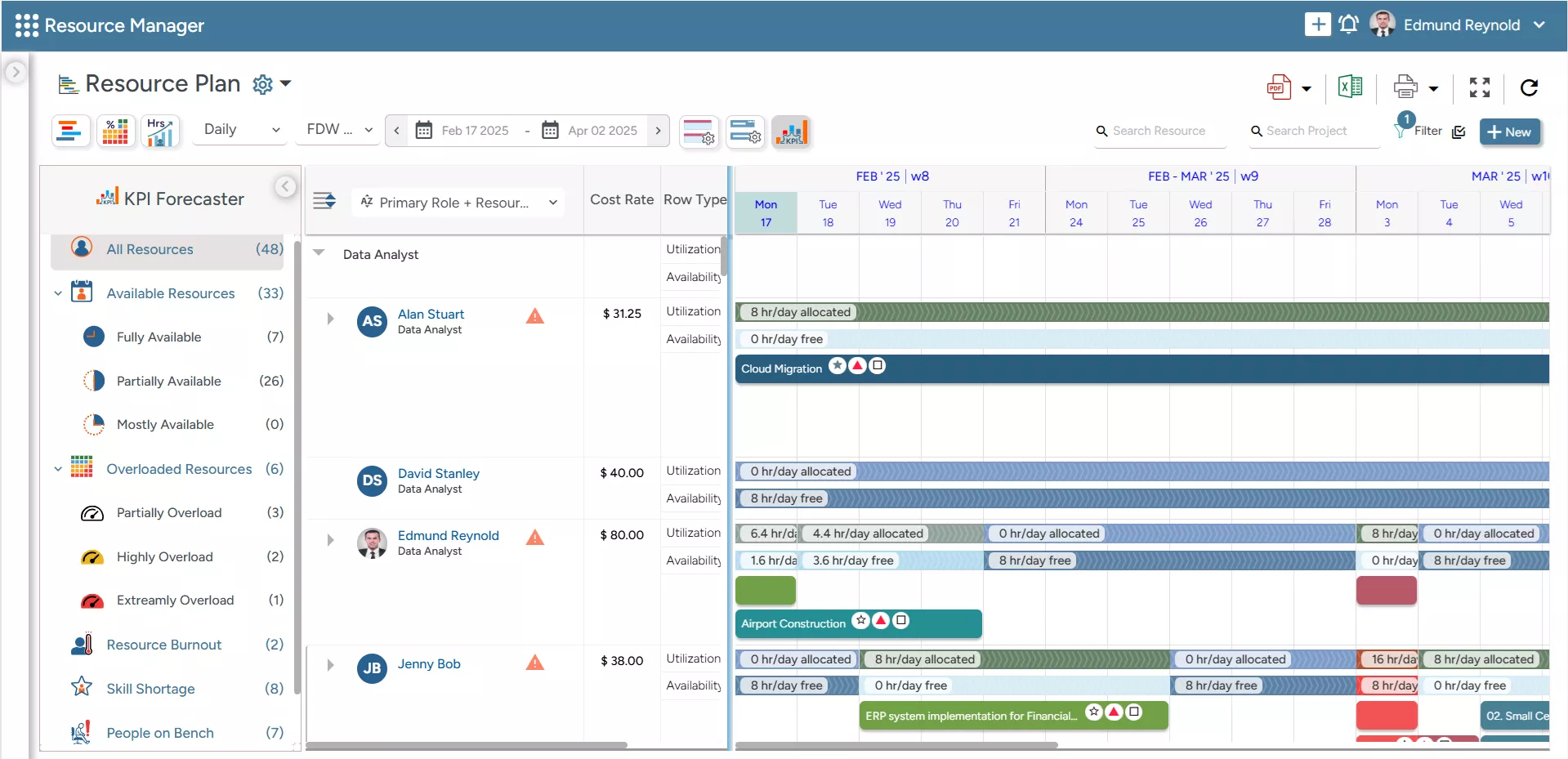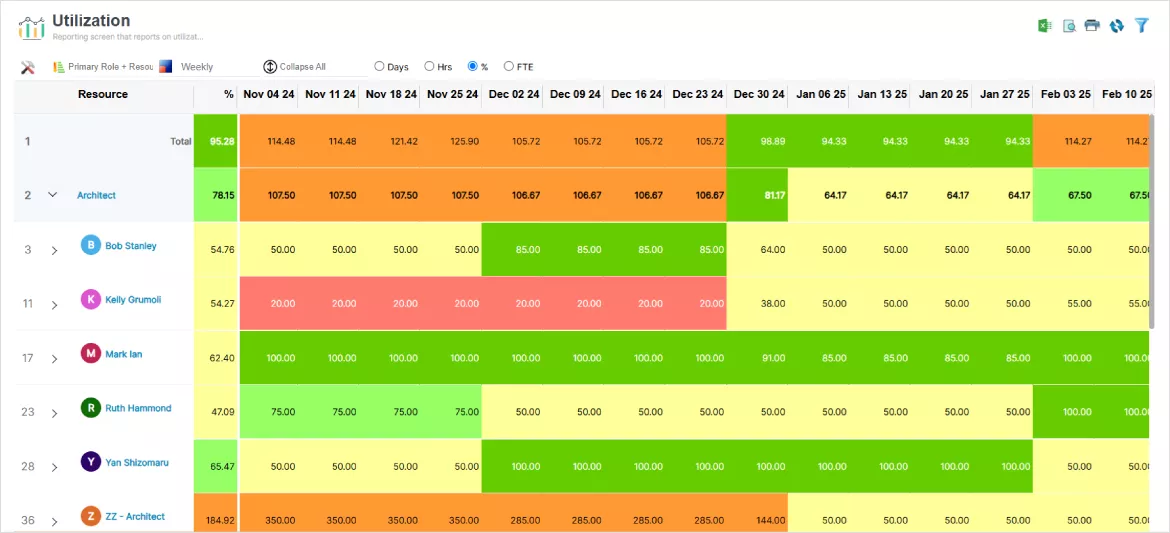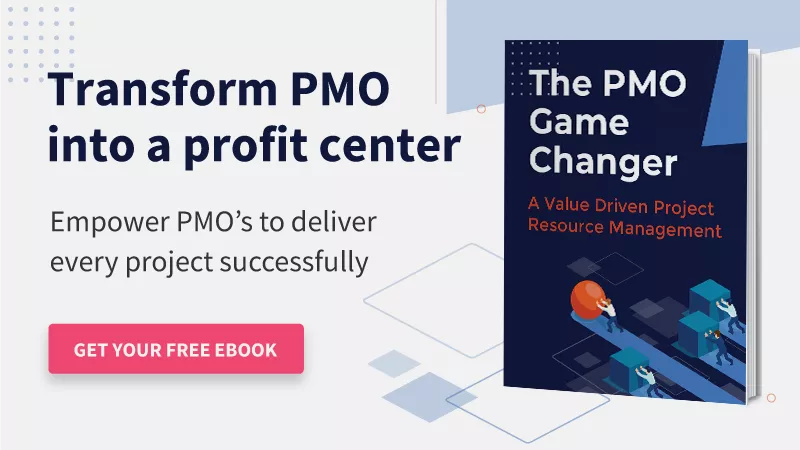In the current business landscape, defined by disruptive technologies, rising operational costs, market volatility, and high stakeholders’ expectations, managing projects has become more complex than ever before. Thus, synchronizing different aspects of the project, including resources, methodologies, and processes, can often feel overwhelming for a project manager.
To address this complexity and make every project a success, many organizations have adopted project integration management as a standard practice. It helps managers oversee various components holistically, manage resources efficiently, and mitigate risks proactively to ensure project profitability and gain a competitive advantage.
At its core, project integration management ensures all processes within a project run smoothly and resources stay on track to achieve the intended goal.
In this blog, we will learn about project integration management, its importance, key steps, and effective implementation strategies for successful execution.
Let’s get started.
What is Project Integration Management?
According to PMI, “Project Integration Management helps to identify, define, combine, unify, and coordinate different processes and activities with project management process groups.”
In simple terms, project integration management is a structured approach for coordinating all the processes and activities to ensure seamless workflow, from initiation to closure. It assures that all project parts, such as scope, time, cost, quality, resources, and risks, are aligned and directed toward the overarching business goals.
Additionally, it includes managing project interdependencies, resolving conflicts, facilitating communication, and ensuring that all aspects of the project are well-coordinated and documented.
With a clear understanding of project integration management, let’s look at some key tools that support its successful implementation.
Project Integration Management Tools
The right tools simplify project integration management by improving planning, coordination, and execution across teams and processes. They are:
Gantt Chart
A Gantt chart, a type of bar chart, is a visual representation of the project tasks and activities displayed along with the duration and milestones. It outlines all the tasks in the project and systematically shows the task interdependencies and the current schedule of those tasks.

SAVIOM’s Gantt Chart enables users to view and manage tasks, deliverables, timelines, and resource allocation seamlessly on a single platform
Kanban Boards
Kanban boards help visualize the flow of tasks using cards and columns, enabling managers to organize work, track progress, and identify bottlenecks beforehand. This allows them to improve efficiency and team collaboration to ensure successful project delivery.
Project Management Software
Project management software has all essential project management functions such as resource allocation, task scheduling, risk management, and progress tracking under one platform. In addition, these tools improve transparency by providing real-time updates, centralized data access, and integrated communication channels.
Read More: 12 Essential Project Management Principles for Successful Execution
Having identified the tools, let’s better understand project integration management with a simple example.
Example of Project Integration Management
Let’s assume a company oversees a large-scale construction project to build a 12-story commercial office. The project manager develops a unified plan integrating architectural designs, material schedules, subcontractor timelines, and regulatory approvals. This plan ensures all teams work in sync, avoiding delays, budget overruns, and miscommunication.
As the project progresses, the manager monitors performance, manages changes (such as client-requested interior design preferences), and ensures all stakeholders remain aligned. By orchestrating the moving parts such as resource allocation, schedule adjustments, and raw-material procurement, the project is delivered on time, within budget, and meets quality standards.
This scenario demonstrates the value of project integration management in delivering successful outcomes. Now, let’s understand the significance of implementing integrated project management.
Importance of Project Integration Management
Here’s a rundown of the key benefits of project integration management:
Aligns Project Goals with Business Objectives
Integrated management connects tasks, deliverables, and resources to the project and company strategy. Thus, it ensures that project goals support the overall business objectives, whether increasing market share, delivering customer value, or enhancing operational efficiency.
Read More: 25 Business Objectives That Every Firm Must Measure for Success
Ensures Coordination Across All Project Elements
Project integration management ensures that all aspects of a project, such as tasks, resources, stakeholders, and objectives, work together in sync. This minimizes inefficiencies, prevents miscommunication, eliminates redundancies, and ensures smooth workflow across departments and teams.
Enhances Communication Among Teams & Stakeholders
Project integration management ensures that all the stakeholders and team members know the progress, changes, and key decisions. This approach helps avoid confusion, ensures smooth collaboration, and helps keep teams and project stakeholders aligned toward shared goals.
Read More: Who are Project Stakeholders? 7 Effective Ways to Manage Them
Keeps Projects on Schedule and within Budget
By coordinating timelines, tasks, and resources, integration management ensures that the project stays aligned with the specified time and budget. It helps managers quickly assess any deviation from the decided timeline or project budget and make timely adjustments to avoid potential delays or unexpected cost escalations.
Facilitates Data-Driven Decision-Making
Proper integration clearly defines every responsibility and step in a project, facilitating better decision-making during the course of the project. Moreover, it provides clear information about project progress, risks, and changes, allowing managers to make informed and data-driven decisions to keep the project on the right track.
Read More: How Can You Make Data-Driven Decisions with Resource Management Software?
Keeping these benefits in mind, project managers must follow seven essential steps to apply integration management to any project. Let’s dive deep into it.
7 Steps of Project Integration Management (PIM)
To effectively implement project integration management, managers can follow the below-mentioned steps:
Develop a Project Charter
The first step is to develop a project charter that formally authorizes a project. A project charter outlines purpose, high-level scope goals, timelines, budgets, key stakeholders, and deliverables and assigns a project manager. It also defines success criteria, budget estimates, and milestones. Thus, it allows managers to lead the project efficiently from initiation to closure.
To create a charter, managers can align business goals with project objectives, define scope and risks, and forecast the cost-profit ratio. Additionally, they may take reference from supporting documents like the business case or assumption log. This step ensures everyone understands the project’s intent and direction before execution begins.
Create a Project Management Plan
The second step is to create a project management plan that outlines the deliverables, timelines, milestones, and success metrics. It also includes creating a work breakdown structure (WBS) to divide activities into small, manageable tasks. Thus, a project plan acts as a guide for timely project execution, resource scheduling, and informed decision-making.
Additionally, project planning also involves developing a comprehensive resource plan. For that, managers can identify resource needs in advance and assess capacity and demand. Furthermore, they can bridge skill gaps by upskilling benched resources or hiring an on-demand/permanent workforce. It eliminates last-minute hiring costs incurred by the firm.
Read More: How to Build a Work Breakdown Structure? A Step-by-Step Guide
Direct and Manage Project Work
In this step, the team executes the project plan by performing assigned tasks and achieving goals on time and within budget. Here, the manager oversees daily operations, monitors progress, conducts meetings, ensures smooth coordination, and handles resource management. These activities enable the successful integration of all project functions.
The aim is to ensure that all resources perform efficiently while maintaining strong team collaboration. Moreover, the manager identifies and addresses risks, resolves conflicts, and integrates approved changes to keep the project on track. Continuous communication and tracking of deliverables ensure quality and strategic alignment.
Manage Project Knowledge
“Manage Project Knowledge,” introduced in PMBOK 6th edition, focuses on using existing insights and acquiring new knowledge to achieve project objectives. This step ensures every resource understands what to know and when which fosters informed decision-making and improves the effectiveness of task execution across all phases.
New knowledge acquired during the project execution adds to the company’s knowledge. It enhances intellectual assets and encourages knowledge sharing. Hence, documenting and sharing this knowledge enables teams to apply lessons learned in future projects to avoid past mistakes and drive continuous innovation.
Read More: 12 Project Management Lessons We Can Learn from Our Favorite Superheroes
Monitor and Control Project Work
Monitoring and controlling project work ensures balance across all project areas, like time, scope, cost, quality, etc. Since these components are interconnected, they cannot be carried out in silos. Hence, they should be continuously monitored to identify early deviations, enabling timely corrective actions to align the project with objectives.
For that, the manager can regularly conduct earned value analysis to assess the progress against planned scope, cost, and schedule. Tracking performance, reviewing updates, and managing change effectively ensures that the project stays aligned with the charter and delivers expected outcomes.
Perform Integrated Change Control
Project changes can be disruptive if not managed effectively. Therefore, managers must assess every change request in this step to avoid scope creep. The change control board (CCB) reviews these requests, evaluates alternatives, and considers the impact on project objectives, timelines, deliverables, and stakeholder expectations.
Furthermore, integrating approved changes smoothly with the ongoing activities is vital. This involves documenting requests in a change log, identifying affected items, and auditing configurations to ensure accuracy. Moreover, a structured change control process helps maintain baseline integrity while enabling necessary adjustments.
Read More: What is Change Management in Project Management, and Why Is It Important?
Close the Project
The last step is to close the project once it is completed and deliverables have received final client acceptance. Closure includes conducting a project review, final stakeholder meetings, closing contracts, and obtaining sign-offs. The process helps identify successes, shortcomings, and lessons learned to improve future projects.
The closure also involves archiving project records, updating documentation, and releasing resources. These activities ensure all project elements are fully integrated and accounted for. Moreover, the gained insights serve as a valuable reference for future projects, helping to refine integration practices and align execution with strategic goals.
Now that we have reviewed the key steps let’s explore how to effectively put project integration management into practice.
How to Effectively Implement Project Integration Management?
Below mentioned are a few strategies to implement project integration management effectively:
Foster a Culture of Collaboration & Transparency
Bringing teams from different departments together builds trust and improves cross-departmental coordination. It creates a shared understanding of project goals, reduces confusion, and encourages open communication. This results in improved collaboration, faster decision-making, and smoother execution of interconnected project tasks.
Read More: 10 Ways to Improve Cross-Departmental Collaboration
Build a Diverse & Competent Project Team
A strong project team includes people with different skills, backgrounds, and strengths. This allows the team to handle technical tasks, creative work, and problem-solving more effectively, bringing new ideas to the table. However, the manager must match tasks with team members’ expertise and make sure they have the required tools for quality deliverables.
Set Clear Communication Protocols
Communication protocols help teams stay organized and avoid misunderstandings. By deciding which tools to use for different types of updates, like email for formal notes and messaging apps for quick questions, everyone knows what to expect. This keeps information flowing smoothly and avoids delays caused by miscommunication.
Read More: What is Project Communication Management? Types, Benefits & Best Practices
Streamline Tools, Systems & Processes
Using the right tools, systems, and processes helps teams work better. It reduces duplication, avoids confusion, and keeps project data centralized in one place. Moreover, a consistent setup across teams makes tracking progress, sharing updates, and managing changes easier.
Monitor Key Project Metrics
Tracking key project metrics helps managers understand how well the project is going. It gives valuable data about time, cost, quality, and progress. This allows managers to make data-driven decisions and adjust plans if needed. Regularly checking these metrics keeps the team focused and improves future project management.
Read More: 7 Critical Project Metrics that You Should Track
After understanding how to implement project integration management, let’s explore how resource management software can make the process easier.
How Can Advanced Resource Management Software Help?
With the right resource management software, managers can efficiently plan, assign, and track project resources while reducing risks and delays. Here’s how:
- The all-in-one resource planner allows managers to filter resources by role, skill, experience, cost, and location. This ensures optimal resource alignment with project tasks, which is key to developing and executing an integrated project plan.
- The smart KPI forecaster helps managers gain foresight into resource-centric KPIs like capacity, utilization, availability, skill shortages, people-on-the-bench, etc. This supports data-driven decision-making and performance monitoring, allowing proactive control of project health.

SAVIOM’s KPI Forecaster offers insights into crucial resource-centric KPIs such as availability, capacity, skills, utilization, etc., to enable data-driven decision-making.
- The embedded capacity planner helps forecast future demand and identify resource shortages or excess. This helps managers plan ahead, align resources strategically, and avoid bottlenecks.
- The embedded heatmaps with color codes help balance workloads by showing real-time availability and usage of resources.

SAVIOM’s Color-coded Embedded Heatmaps provide in-depth insights into the utilization level of every resource.
- The actual vs. forecast time report helps compare planned timelines with real execution data to prevent delays, cost variances, and scope creep.
- The Gantt Chart feature visually displays timelines, task dependencies, and project milestones to help identify deviations early and adjust accordingly.
- The task management feature ensures skilled resources are assigned to each task so that dependencies are completed on time. This helps in maintaining workflow continuity and process synchronization.
Conclusion
An integrated view of project resource plans and schedules is essential for maximum productivity. All elements, including scope, resources, schedule, and stakeholder expectations, should be aligned appropriately for effective project integration management. Moreover, the project manager can ensure low risk, improve communication, and control project workflows by following the above mentioned steps.
How do you manage resources and processes at your organization?
The Glossary
Read More: Glossary of Resource Workforce Planning, Scheduling and Management












